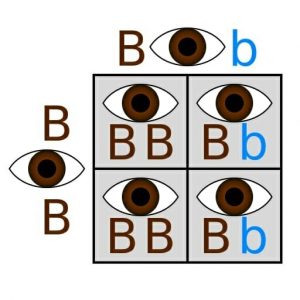Independent Assortment Definition
Independent assortment is a genetic term that refers to the variation of chromosomes, or genetic information, during sex cell division. This variation allows for genetic differentiation in offspring.
The Principle of Independent Assortment
Not surprisingly, the principle of independent assortment applies to the definition of independent assortment. It consists of two parts, the first dealing with cell division, and the second covering how those cells produce offspring.
The first part of the principle of independent assortment is basically the definition of independent assortment. It states that, when sex cells undergo meiosis, or division, they do not make exact copies of the parent’s genotype. Instead, they form unique combinations of alleles, or dominant and recessive genes, that may express themselves differently than those of the parent.
The principle of independent assortment also covers how divided sex cells undergo recombination to produce unique offspring. Differentiated from the parent in meiosis, the genetic information on one set of sex cells pairs with the genetic information on another set of sex cells, provided by the other parent. Because neither set of genetic information is wholly dominant, offspring express a phenotype, or physical traits, that resemble both parents.
Examples of Independent Assortment
Punnett Squares
As mentioned above, parent sex cells contain alleles that combine with other parent cells to produce the offspring’s phenotype. While these alleles follow the principle of independent assortment in that they differ from sex cell to sex cell, parents can predict their offspring’s phenotype using a Punnett square.
Punnett squares combine a knowledge of family genetic history with parent phenotypes to produce a matrix of possible offspring phenotypes. To create a Punnett square, parents determine whether they have the dominant allele (D) or the recessive allele (d) of a visible trait. If a parent has a recessive allele, the genotype, or scientific notation of the allele, is dd. If a parent has a dominant allele, the genotype is Dd or DD. Parents with dominant alleles may make more than one Punnett square.
Parents then arrange their genotype variants vertically and horizontally, below a graph. They combine these genotypes until the matrix is filled, showing all the possible phenotypes for offspring. While Punnett squares for single-gene traits (like those pictured below) tend to produce only four possible phenotypes, there are traits whose genetic structures are so complex, they produce hundreds of possibilities. Nonetheless, Punnett squares make independent assortment more predictable.
The first image below shows Punnett squares for a parent with blue eyes, while the second image shows Punnett squares for a parent with brown eyes.
Long Eyelashes
Having long eyelashes is defined as having eyelashes that are more than one centimeter (1 cm) in length. It has been suggested that testosterone factors into eyelash length, as more males have long eyelashes, than females.
Genetically speaking, long eyelashes are dominant traits, which means they have the genotype LL or Ll. Short eyelashes, on the other hand, are only ll. These combinations come from parent sex cells, which carry either L or l.
Take for example, a male and female that both have long eyelashes. The male carries the genotype LL, however, and the female carries the genotype Ll. This means that the parent sex cells that created the male both carried the L gene. The female, on the other hand, had a parent who carried gene L, and another parent who carried gene l.
If the male and the female decide to become parents themselves, the law of independent assortment dictates that their sex cells will carry a random assortment of their genotype for long eyelashes. In this case, it means that the male will carry gene L, and that the female will carry gene L or gene l. When examined in a Punnett square, this means that their offspring will have long eyelashes, either genotype LL or genotype Ll.
Related Biology Terms
- Meiosis – Sex cell division, in which cells divide into four daughter cells that each contain a half-set of genetic information.
- Allele – A possible expression of a gene, either dominant or recessive.
- Recombination – The process that combines the independently-assorted genes from parent sex cells to create the genotype, and inform the eventual phenotype, of offspring.
- Phenotype – The physical manifestation of a genotype.
Quiz
1. The principle of independent assortment states that the genetic information on parent sex cells may be __________ to/than that of the parent’s own genotype.
A. Superior
B. Identical
C. Different
D. Stranger
2. A parent with the genotype GG for a trait may carry gene _____ or gene ______ on their sex cells.
A. G, G
B. g, g
C. H, H
D. G, g
3. Parents may have offspring who look nothing like them because __________.
A. The offspring have inherited genotype gg, and both parents have genotype Gg.
B. The offspring have inherited genotype GG, and both parents have genotype gg.
C. The offspring have inherited genotype Gg, and both parents have genotype GG.
D. The offspring have inherited genotype gg, and both parents have genotype GG.


